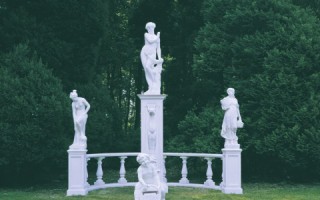Timothée Chaillou: What does the pedestal/podium evoke for you? What does it allow you to achieve?
Guillaume Bijl: I have sometimes used pedestals or podiums to accentuate the realism of my form of realism – in installations like Miss Hamburg (1988), Tombola Prizes (1988) or A Band (1988). A podium helps give the viewer a better idea of what the subject is all about.
Timothée Chaillou: Why is it important for you to categorize your types of work within a precise definition – characterizing what they are and what they are not? Is the reason educational?
Guillaume Bijl: Art writers and critics have frequently misinterpreted my work – that’s why I began categorizing it into different types. And also because I have produced a number of variations on my early works. So I organized my work into the following categories:
– Transformation-Installations: reality in non-reality (an art space)
– Situation-Installations: non-reality in reality (a public space)
– Compositions: present-day archeological still-lifes
– Sorry Works: sort of absurd and abstract works
And in recent years I have done a lot of works that deal with ‘Cultural Tourism.’
Timothée Chaillou: Does your work imply audience participation?
Guillaume Bijl: With the installations, the audience becomes a sort of theatre actor without explicitly realizing it. I create a sort of trompe-l’œil situation with my installations. I work in the fields of fiction and reality.
Timothée Chaillou: Have you ever painted still lifes? Would you say that your installations are 3-D versions of your painted works?
Guillaume Bijl: I started as a self-taught artist working in different styles but I wasn’t happy about the medium I was using to fulfil my aims. I wanted to get the audience more involved and started making installations that were a bit ‘tongue in cheek.’
Timothée Chaillou: Please tell us about your 1979 manifesto.
Guillaume Bijl: It was a ‘State Manifesto’ entitled The Art Liquidation Project, with the State declaring art superfluous and planning to close down all art venues and transform them into more functional institutions or businesses – like psychiatric hospitals, shooting-ranges, travel agencies, driving schools, etc. The text was the basis of my Transformation-Installations. This type of installation insinuates that the gallery or art space has gone bust and become a supermarket or Matrass-discount (an underlying meaning of these installations).
— This is only a short extract, the full conversation is available in the fifth issue of Annual Magazine. Shop it here!


